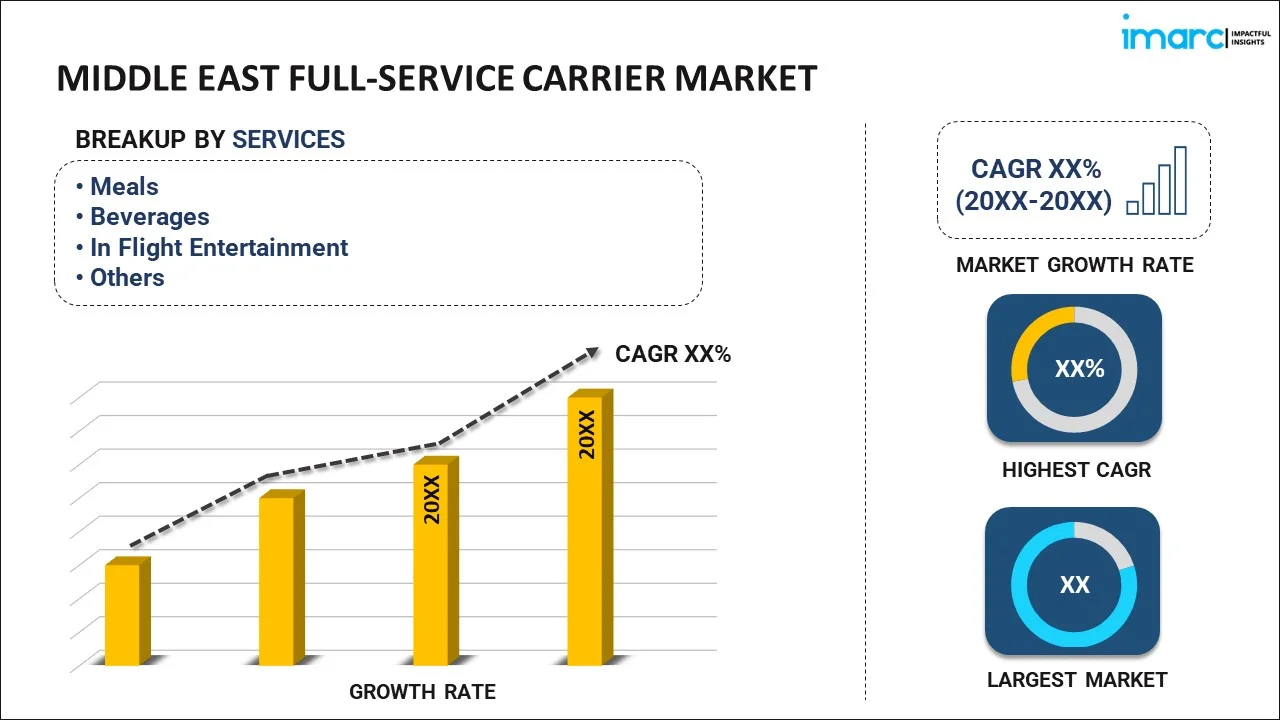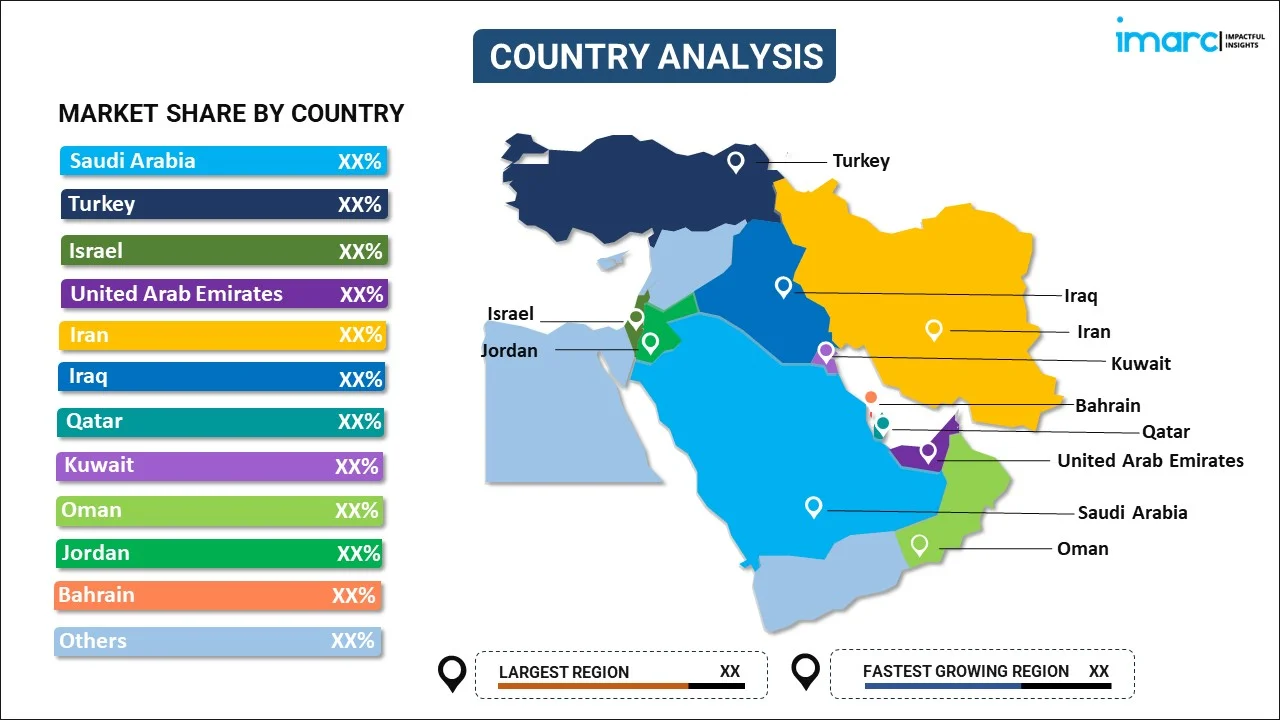
Middle East Full-Service Carrier Market Report by Service (Meals, Beverages, In Flight Entertainment, and Others), Application (International Aviation, Domestic Aviation), and Country 2024-2032
Market Overview:
Middle East full-service carrier market size is projected to exhibit a growth rate (CAGR) of 5.80% during 2024-2032. The growing awareness of environmental issues that has led to increased emphasis on sustainable practices and fuel-efficient aircraft, which can impact the operational choices of full-service carriers, is driving the market.
|
Report Attribute
|
Key Statistics
|
|---|---|
|
Base Year
|
2023 |
|
Forecast Years
|
2024-2032
|
|
Historical Years
|
2018-2023
|
| Market Growth Rate (2024-2032) | 5.80% |
A full-service carrier, commonly referred to as a traditional or legacy airline, is an airline that provides a comprehensive range of services to passengers. These carriers typically offer various classes of seating, including first, business, and economy, and provide amenities such as in-flight meals, entertainment, and checked baggage as part of the standard ticket price. Full-service carriers often operate on a hub-and-spoke model, using major airports as central hubs for connecting flights to various destinations. They tend to have larger fleets, offering a wide network of routes and frequent flights. Additionally, full-service carriers generally have a more extensive ground infrastructure, including airport lounges and dedicated check-in counters. While they may face competition from low-cost carriers, full-service carriers distinguish themselves by emphasizing a more comprehensive and premium travel experience for passengers.
Middle East Full-Service Carrier Market Trends:
The full-service carriers market in the Middle East is propelled by several key drivers. Firstly, the regional surge in travel demand has been a primary force behind the expansion of full-service carriers. As economies grow and disposable incomes rise, more individuals are inclined to explore distant destinations, fostering a steady demand for comprehensive air travel services. In addition to this, the strategic alliances and partnerships formed by full-service carriers contribute significantly to their market dominance. Collaborations with other airlines, as well as with travel and hospitality entities, enable full-service carriers to offer extensive route networks and integrated travel solutions. This interconnectedness strengthens their competitive edge in the market. Technological advancements also play a crucial role in shaping the full-service carriers landscape, with carriers constantly investing in cutting-edge aircraft, digital services, and customer experience enhancements. These technological upgrades not only enhance operational efficiency but also appeal to the modern traveler's expectations for seamless and digitally integrated travel experiences. In conclusion, the regional full-service carriers market is intricately interwoven with economic trends, strategic collaborations, and technological advancements, making it a dynamic and evolving sector within the aviation industry.
Middle East Full-Service Carrier Market Segmentation:
IMARC Group provides an analysis of the key trends in each segment of the market, along with forecasts at the regional and country levels for 2024-2032. Our report has categorized the market based on service and application.
Service Insights:

- Meals
- Beverages
- In Flight Entertainment
- Others
The report has provided a detailed breakup and analysis of the market based on the service. This includes meals, beverages, in flight entertainment, and others.
Application Insights:
- International Aviation
- Domestic Aviation
A detailed breakup and analysis of the market based on the application have also been provided in the report. This includes international aviation and domestic aviation.
Country Insights:

- Saudi Arabia
- Turkey
- Israel
- United Arab Emirates
- Iran
- Iraq
- Qatar
- Kuwait
- Oman
- Jordan
- Bahrain
- Others
The report has also provided a comprehensive analysis of all the major regional markets, which include Saudi Arabia, Turkey, Israel, United Arab Emirates, Iran, Iraq, Qatar, Kuwait, Oman, Jordan, Bahrain, and Others.
Competitive Landscape:
The market research report has also provided a comprehensive analysis of the competitive landscape. Competitive analysis such as market structure, key player positioning, top winning strategies, competitive dashboard, and company evaluation quadrant has been covered in the report. Also, detailed profiles of all major companies have been provided.
Middle East Full-Service Carrier Market Report Coverage:
| Report Features | Details |
|---|---|
| Base Year of the Analysis | 2023 |
| Historical Period | 2018-2023 |
| Forecast Period | 2024-2032 |
| Units | US$ Million |
| Scope of the Report | Exploration of Historical and Forecast Trends, Industry Catalysts and Challenges, Segment-Wise Historical and Predictive Market Assessment:
|
| Services Covered | Meals, Beverages, In Flight Entertainment, Others |
| Applications Covered | International Aviation, Domestic Aviation |
| Countries Covered | Saudi Arabia, Turkey, Israel, United Arab Emirates, Iran, Iraq, Qatar, Kuwait, Oman, Jordan, Bahrain, Others |
| Customization Scope | 10% Free Customization |
| Report Price and Purchase Option | Single User License: US$ 3699 Five User License: US$ 4699 Corporate License: US$ 5699 |
| Post-Sale Analyst Support | 10-12 Weeks |
| Delivery Format | PDF and Excel through Email (We can also provide the editable version of the report in PPT/Word format on special request) |
Key Questions Answered in This Report:
- How has the Middle East full-service carrier market performed so far and how will it perform in the coming years?
- What has been the impact of COVID-19 on the Middle East full-service carrier market?
- What is the breakup of the Middle East full-service carrier market on the basis of service?
- What is the breakup of the Middle East full-service carrier market on the basis of application?
- What are the various stages in the value chain of the Middle East full-service carrier market?
- What are the key driving factors and challenges in the Middle East full-service carrier?
- What is the structure of the Middle East full-service carrier market and who are the key players?
- What is the degree of competition in the Middle East full-service carrier market?
Key Benefits for Stakeholders:
- IMARC’s industry report offers a comprehensive quantitative analysis of various market segments, historical and current market trends, market forecasts, and dynamics of the Middle East full-service carrier market from 2018-2032.
- The research report provides the latest information on the market drivers, challenges, and opportunities in the Middle East full-service carrier market.
- Porter's five forces analysis assist stakeholders in assessing the impact of new entrants, competitive rivalry, supplier power, buyer power, and the threat of substitution. It helps stakeholders to analyze the level of competition within the Middle East full-service carrier industry and its attractiveness.
- Competitive landscape allows stakeholders to understand their competitive environment and provides an insight into the current positions of key players in the market.
Need more help?
- Speak to our experienced analysts for insights on the current market scenarios.
- Include additional segments and countries to customize the report as per your requirement.
- Gain an unparalleled competitive advantage in your domain by understanding how to utilize the report and positively impacting your operations and revenue.
- For further assistance, please connect with our analysts.
 Inquire Before Buying
Inquire Before Buying
 Speak to an Analyst
Speak to an Analyst
 Request Brochure
Request Brochure
 Request Customization
Request Customization




.webp)




.webp)












